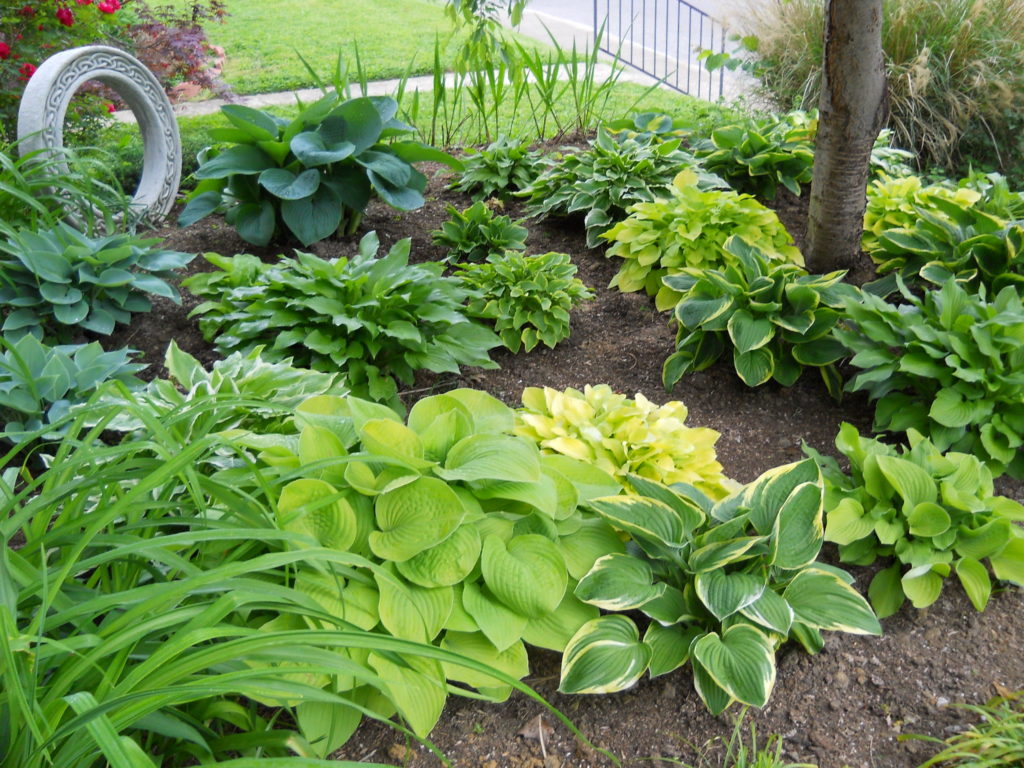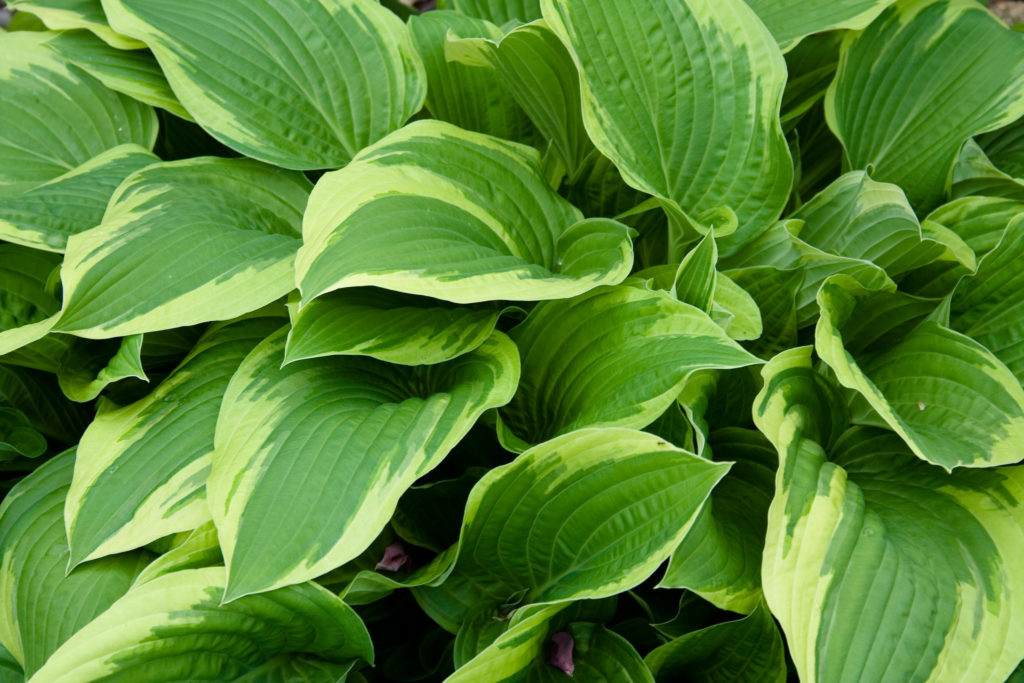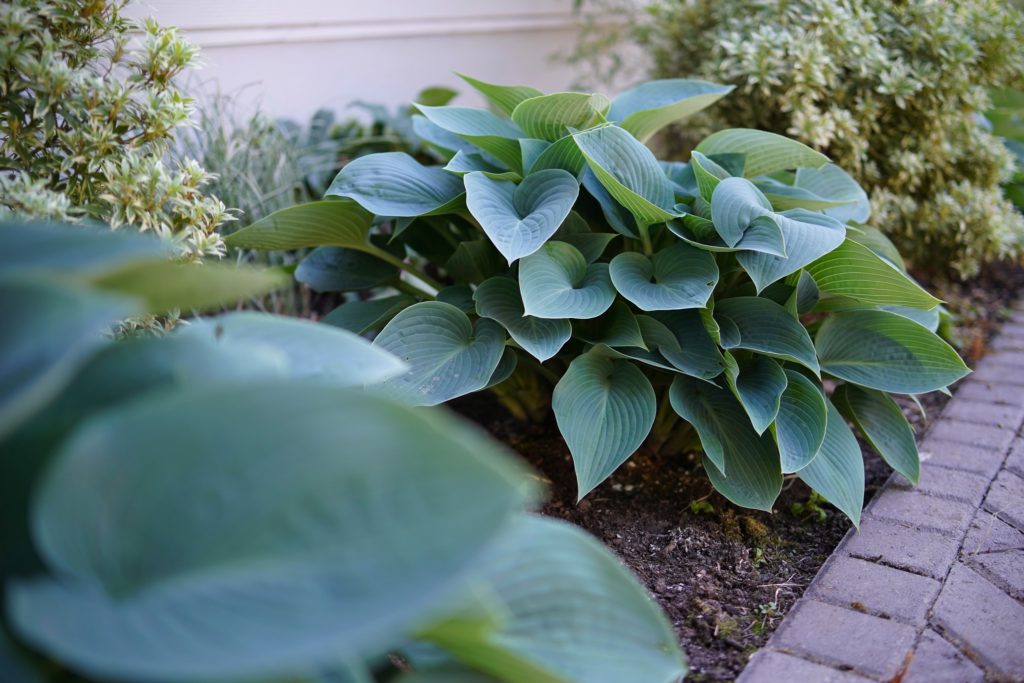Hosta is the genus of a large family of plants, meaning there are a huge number of species that are considered Hostas. Hostas as a group are also called Plantain Lilies. They are an ideal flowering shrub for your garden, and they are often used as a border plant, or to beautify a shady corner of your yard. They originated in Asia and have been used as woody perennials in the United States since the 1800s. They vary a great deal in color and size. Average Hosta plants are usually about 3 to 4 feet in diameter, and 12-24” tall. Giant hostas can be much larger, up to 4 feet tall, and 5-6 feet wide, and miniature hostas are much smaller, with the tiniest plants being less than 12” tall and 12” wide. This plant prefers soil that is somewhat acidic. They are perfect for a shady area, a Hosta plant prefers partial shade, and they can be used to fill in where other plants that need full sun won’t easily grow.
Types of Hostas
Some of the most popular Hostas include the blue and lavender Halcyon Hosta, the yellow-green Guacamole Hosta, the yellow August Moon Hosta, and the blue-green and gold Frances Williams Hosta. Besides these, there are many other types, big and small with a huge variety of colors. They all are pretty easy to grow, need minimal sun, but do require some care. Generally speaking, the lighter-colored varieties do better with a little sunlight, and the darker-colored Hostas need more shade.
- Hosta
- Perennial
- Partial shade
- Moist and well-drained acidic soil (4.5 to 5.5 pH).
- Start seedlings or cuttings indoors in the late fall.
- Plant in the garden 2 weeks after the last frost in spring.
- Plant 48″ apart for most healthy shrubs.
- Growing in containers:
Start single plants in at least 12″ deep, and 16″ wide pots
Move to a larger pot as the plant grows, the final pot should be as wide as the foliage.
Ensure good drainage and acidic soil
- Water regularly, keeping the soil moist.
- Climate Zones 6-9 for evergreen varieties
- Climate Zones 4-9 for deciduous varieties

Planting Hostas
Hostas are adaptive and can be planted in a variety of places. The main thing to remember is that they need some shade, and don’t do well in full sun. When choosing a spot in your garden or yard, remember a few key things: First, ideal soil conditions are somewhat acidic. The best range is usually 4.5-5.5 PH. It can be somewhat more neutral than that, but they do better with acid soils. Second, they need space! Most commonly a Hosta plant will be about 3-4 feet wide depending on the variety at full maturity, and its roots need the same amount of space. For an average-sized hosta, space them about 4 feet apart. Dig a wide hole, about the width of the plant at full size, and about 1 foot deep. Plant the hosta plant and fill it in with slightly acidic, fertile compost and garden soil up to ground level. It’s a good idea to plant with some organic fertilizer on or in the soil as well to boost growth. Lastly, ensure that the area is planted in is not in full sun! These are great for areas around your garden that don’t get as much sun as the herb or flower beds.
It’s best to plant hostas in the spring or fall, and not in midsummer or midwinter. They are perennial shrubs, and they do better in the heat of summer and the cold of winter after being established. As newly planted shrubs, they need a chance to grow out their root systems before hitting those extreme temperatures. Some hostas are characterized as “evergreen” hostas, these need somewhat warmer temperatures. Others are called “deciduous” hostas. These lose their leaves in the winter and grow back in the spring. They can withstand much colder winters after they have grown in.

Hosta Companion Plants
Companion plants that do well with hosta plants should also prefer acidic soil and shade, or provide shade for the hostas. Other flowering shrubs like azaleas and hydrangeas do very well alongside hostas, and some flowers do well also, like daffodils, hyacinths, and begonias. Red oak trees have been known to do very well as companions for hostas since they have very deep roots that don’t interfere with the hosta roots, also prefer acidic soil, and provide excellent shade for the hosta plants.
Hostas have a few common pests, specifically slugs, and snails. These can be discouraged by mulching, putting some sand in a circle around the plant, or using diatomaceous earth or even broken egg shells. None of these is a perfect defense, and it’s good to keep an eye out for these troublesome pests. Halcyon hostas are known to be somewhat slug and snail-resistant. It’s also good to be aware that rabbits and deer will eat hostas if they have access to the plants. Some diseases that can trouble hostas are anthracnose, leaf rot, and crown rot (fusarium rot). These are not common and can be avoided by being careful when transplanting, and taking care that the garden bed is well drained. There is a new disease, Hosta Virus X, which causes yellowing and withering of leaves, and colors merging on leaves. Affected plants should be destroyed and not mulched, and care should be taken to wash tools and hands thoroughly before going near or touching another hosta plant.
Fun Facts About Hostas
One thing that is not well known about hosta plants is that the leaves are actually edible! The young leaves can be used as tasty leafy greens in any recipe, and the flowers can be used in dishes as well. The older mature leaves are somewhat bitter, so it is best to harvest a few leaves early in the year if you are wanting to eat them. It’s important to note that while hostas are edible for humans, rabbits, and deer, they are toxic to dogs and cats. It’s best to keep them fenced both to protect the hostas from being eaten by deer or rabbits if they are in your area, and to protect your household pets from these greens if needed.

Hostas generally are bred to look a certain way by crossbreeding. To reproduce them, it is often the best choice to split the plants once they get big or overcrowded. The seeds can be harvested too, though it’s most likely that they won’t breed true to type. The seeds should be gathered in the autumn, and carefully separated from the seed pods, and completely dried. They are best kept in a paper container: a small paper bag or an envelope. They can be planted in spring, a few weeks after the last frost. Take care to dig out the area where the seed will be planted, to the same depth (usually 12 inches) and width (usually 3-4 feet) based on the size of the fully mature plant, and fill in with slightly acidic garden soil and compost, just as you would when planting a transplant or split plant.
Hostas are a great choice for your garden or yard, especially for brightening up shady areas on the north-facing side of your house, or under a tall and leafy tree. They are very low-maintenance but do require some care. Make sure to keep them weed-free, and apply some slow-release or organic fertilizer in the spring each year, if they are struggling at all. If you’re growing hostas in your garden, post some photos and share your experience growing them in our gardening community!








